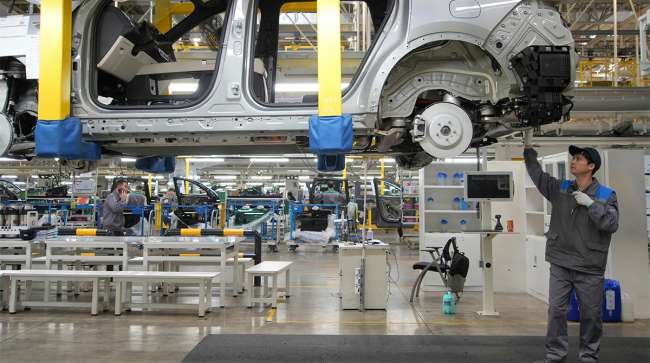The Detroit News
Biden Administration Proposes Ban on Chinese Vehicle Tech

[Stay on top of transportation news: Get TTNews in your inbox.]
WASHINGTON — The Biden administration introduced a draft regulation Sept. 23 that would ban automakers in the United States from selling vehicles with important components and software from China and Russia.
The proposal follows a probe launched in February by the U.S. Department of Commerce into the national security risks of internet-connected vehicle technology from China.
“Cars today have cameras, microphones, GPS tracking, and other technologies connected to the internet. It doesn’t take much imagination to understand how a foreign adversary with access to this information could pose a serious risk to both our national security and the privacy of U.S. citizens,” said Commerce Secretary Gina Raimondo in a statement.
The move comes as fears grow over China becoming a dominant player in the global automotive industry and Democrats and Republicans seek to appear tough on China ahead of the 2024 presidential election. The draft rules are intended to proactively protect U.S. national security as China automotive technology makes its way into more vehicles around the world, even ones from that come non-Chinese brands.
Big news! @CommerceGov published a proposed rule to secure connected vehicle supply chains from foreign adversary threats. This rule would protect our national security by prohibiting certain tech from PRC and Russia. Read more here: https://t.co/ygicfr0N7Q — BISgov (@BISgov) September 23, 2024
“The good news is right now, we don’t have many Chinese or Russian cars on our roads,” she added in a press call. “But we’ve seen Europe is a cautionary tale. In Europe and elsewhere in the world, they went from very few Chinese cars to many, very quickly ... so we’re not going to wait until our roads are filled with cars and the risk is extremely significant.”
“We’ve already seen ample evidence of (China) pre-positioning malware on our critical infrastructure for the purpose of disruption and sabotage, and with potentially millions of vehicles on the road, each with 10- to 15-year life spans, the risk of disruption and sabotage increases dramatically,” said National Security Adviser Jake Sullivan.
The rule, if adopted, would place restrictions on software beginning in model year 2027. Restrictions on hardware would take effect for model year 2030, or Jan. 1, 2029, for units without a model year.
Senior Biden administration officials explained that they crafted the rule, including those timelines, after extensive feedback from businesses across the U.S. automotive supply chain. They found that software from China and Russia was uncommon enough to allow for a quicker timeline, but it will take more time for the industry to cut its use of hardware from the rival nations.

Raimondo
Raimondo emphasized that the draft rule, which comes from Commerce’s Bureau of Industry and Security, is “not about trade or economic advantage.”
“This is a strictly national security action. We are focused on the national security threat — very real threat that connected vehicles pose to our country and the American people,” she said, perhaps a nod to some industry experts suggesting otherwise.
Lael Brainard, director of the National Economic Council, addressed some of the economic aspects of the rule ahead of its release. “We can’t allow for a situation where our auto supply chains are dependent on China,” she said.
Brainard touted some of the administration’s economic policies regarding China and the auto industry.
“That’s why we put in a 100% tariff on electric vehicles from China,” she said. “And in the Inflation Reduction Act, we tied the $7,500 tax credit for (electric vehicle) purchases to final sourcing in North America. President Biden and Vice President Harris will continue to stand with us, auto workers and automakers as they compete and win in the future.”
U.S. Rep. Debbie Dingell, D-Michigan, praised the rule in a statement Sept. 23.
“As our vehicles become smarter, safer and increasingly connected, it’s important we’re taking action to mitigate security risks, especially when this technology is coming from countries of concern, like China and Russia,” she said. “An investigation by the Department of Commerce concluded that technology from these adversarial countries poses a real risk both to consumers and to American infrastructure.”
Nazak Nikakhtar, an international trade official for the Commerce Department during the Trump administration, said ahead of the rule’s release that she expected it would be easy for U.S. automakers to comply. She also predicted it wouldn’t affect vehicle prices because most companies already have internal compliance teams.
Want more news? Listen to today's daily briefing above or go here for more info
“At the end of the day, it doesn’t change the landscape and the autos market,” she told The Detroit News.
Nikakhtar added that to more thoroughly address the economic and security threats the Chinese auto industry poses to the U.S. and its allies, the U.S. needs more multilateral cooperation and coordinated efforts between countries.
Sullivan suggested the same.
“A number of our allies and partners share these concerns. Just a couple of months ago, we convened over a dozen countries from across the Indo-Pacific, Europe and North America here in Washington to discuss these national security risks. Many of our partners noted that they are contemplating taking their own measures to mitigate these risks,” he said.
There will be a 30-day window for public comments on the draft rule, which senior officials said they hope to finalize before Biden leaves office in January.
Distributed by Tribune Content Agency, LLC




